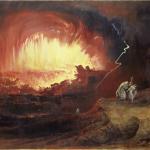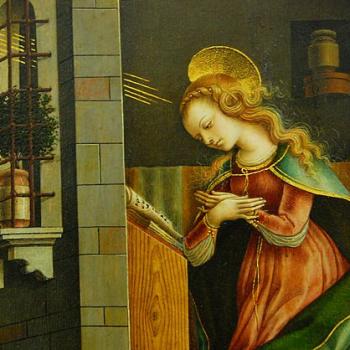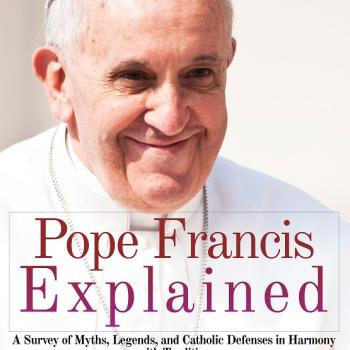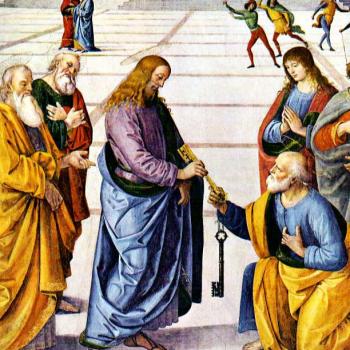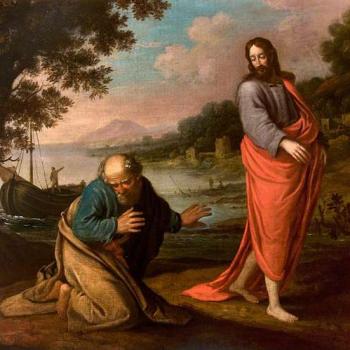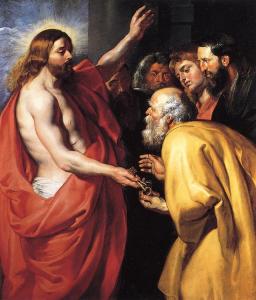
The late Steve Hays was a Protestant Reformed, anti-Catholic apologist, very active online, who ran the site, Triablogue. I am critiquing a portion of his article entitled “Catholic prooftexts” (12-17-17). His words will be in blue.
*****
i) Caesarea Philippi is situated on a rocky terrace at the base of Mt. Hermon. As such, it’s natural to suppose the rocky metaphor was suggested by the immediate surroundings. Jesus was standing on rocky ground, and standing in the shadow of Mt. Hermon, at the time he made his statement.
*
The location does have a large rock facade, which is what Jesus was referring to. But of course metaphors often have a double meaning in Scripture, and Jesus was also quite specifically calling St. Peter the Rock, with the large rock in the background to nail down the point in the imagination of those present. I’ve been there. The spot is actually on the cover of
my book about my trip to Israel in 2014. You can’t really see Mt. Hermon from this spot, even though technically it is at the base of it.
*
This also goes to a difference between the written word and the spoken word. Consider the demonstrative pronoun: “this”. In that setting, it’s easy to imagine him pointing to an actual rocky object. “I will build my church on this!”–accompanied by an illustrative gesture. The repetition of “rock” may well include a reference to Simon, but the double reference may also include a reference to the rocky surroundings. Indeed, that may be primary.
*
We contend that the rocky surroundings are secondary, and the reference to Peter primary. Jesus says, “you are Peter [“rock”], and on this rock [Peter] I will build my church . . .” (Mt 16:18, RSV).
*
“Rock” is probably a double entendre, both for Peter and especially the emblematic location.
*
That far we agree.
*
“Rocky” is a pun in honor of Peter’s insightful confession, but what the church is built on is what the location symbolizes.
*
Many renowned Protestant commentators believe that the “rock” referred to here is
St. Peter himself, not merely — or only — his confession of faith. These include William Hendriksen, Gerhard Maier, J. Knox Chamblin, in Walter A. Eldwell, ed.,
Evangelical Commentary on the Bible, Gerhard Friedrich, ed., and Geoffrey W. Bromley, trans. and ed.,
Theological Dictionary of the New Testament, Craig L. Blomberg, William E. McCumber, in William M. Greathouse and Willard H. Taylor, eds.,
Beacon Bible Expositions, M. Eugene Boring, in Pheme Perkins et al, eds.,
The New Interpreter’s Bible, John A. Broadus, Albert Barnes, David Hill, in Ronald E. Clements and Matthew Black, eds.,
The New Century Bible Commentary,
The New Bible Commentary, Herman N. Ridderbos, R. T. France (see the
documentation for all these).
*
Others include D. W. O’Connor, “Peter,” Micropedia,
Encyclopaedia Britannica, 1985 edition, vol. 9, 330-333,
Henry Alford, William F. Albright, and C.S. Mann,
Anchor Bible,
D. A. Carson, Donald A. Hagner, in David A. Hubbard and others, editors,
World Biblical Commentary (see
further sources for these). Obviously, then, it’s not merely “Catholic bias” that leads to such an exegesis of the passage.
*
ii) In Revelation, the Netherworld is subdivided into a realm of the dead (Rev 20:13-14) and a realm of the demonic (9:1-11; 11:17; 17:8). And keys are associated with each (Rev 1:18; 9:1-2.; cf. 20:1-3). My point is not to use Revelation to interpret Mt 16 directly. Rather, this seems to be stock imagery that was in circulation in Jewish circles.
*
The only problem is that these references refer to a key to the nether world and/or hell, whereas Jesus gave to St. Peter (and him alone), “the keys of the kingdom of heaven” (Mt 16:19). So there is a difference there. Hades and hell are not the “kingdom of heaven”.
*
iii) Caesarea Philippi was pagan territory. In OT times, it may well have been a site of Baal-worship. Later on, it was a shrine for the Greek god Pan. So it would have demonic associations.
*
Exactly. We agree again. And it has a large cave with a huge opening, that was thought by the ancients to go down to Hades.
*
iv) Although Matthew doesn’t fill in the details, the implicit imagery involves a parallel between hades and heaven, where they stand in contrast. Gates imply keys and keys imply gates. If we mentally flesh it out, the reader should visualize both heaven and hades as gated locations.
*
Precisely! But I suspect that Hays would not accept the deeper implications here. Here are what some prominent Protestant commentators think the keys signify:
The keys are the symbol of authority, and Roland de Vaux (Ancient Israel, tr. by John McHugh [New York: McGraw-Hill, 1961], 129 ff.) rightly sees here the same authority as that vested in the vizier, the master of the house, the chamberlain of the royal household in ancient Israel. –W. F. Albright and C. S. Mann, The Anchor Bible: Matthew, (Garden City, NY: Doubleday, 1971), 196.
The image of keys (plural) perhaps suggests not so much the porter, who controls admission to the house, as the steward, who regulates its administration (Is 22:22, in conjunction with 22:15). The issue then is not that of admission to the church (which is not what the kingdom of heaven means; see pp. 45-47) but an authority derived from a delegation of God’s sovereignty. – R. T. France, Tyndale New Testament Commentaries.
The keys of the kingdom would be committed to the chief steward in the royal household and with them goes plenary authority. –George Buttrick and others, eds., The Interpreter’s Bible, (New York: Abingdon, 1951), 453.
These terms [binding and loosing] thus refer to a teaching function, and more specifically one of making halakhic pronouncements [i.e., relative to laws not written down in the Jewish Scriptures but based on an oral interpretation of them] which are to be ‘binding’ on the people of God. In that case, Peter’s ‘power of the keys’ declared in [Matthew] 16:19 is not so much that of the doorkeeper, who decides who may or may not be admitted to the kingdom of heaven, but that of the steward . . . . whose keys of office enable him to regulate the affairs of the household. –R. T. France, Matthew: Evangelist and Teacher, (Grand Rapids, MI: Zondervan, 1989), 247.
In the . . . exercise of the power of the keys, in ecclesiastical discipline, the thought is of administrative authority (Is 22:22) with regard to the requirements of the household of faith. The use of censures, excommunication, and absolution is committed to the Church in every age, to be used under the guidance of the Spirit . . . So Peter, in T.W. Manson’s words, is to be `God’s vicegerent . . . The authority of Peter is an authority to declare what is right and wrong for the Christian community. His decisions will be confirmed by God’ (The Sayings of Jesus, 1954, p. 205). (4: 1018) — New Bible Dictionary.
vi) Given the associations with heathen idolatry, I think hades more likely connotes the realm of the demonic in this evocative setting. Jesus may be boldly saying he will build his Church on top of hellmouth.
It’s the secondary meaning. But the primary meaning of building His church is as He said: “you are Peter [“rock”], and on this rock [Peter] I will build my church . . .” (Mt 16:18). He’s talking about human administration of His Church, which is why He refers to binding and loosing in the next verse: which were rabbinic practices having to do with authority.
*
And the function of the gate may be to block the demonic realm from storming the church.
*
Or vice versa, and the gates cannot retrain the Church from overpowering death and Hades in the end.
*
3. Catholic apologists typically allege that v19 is an allusion to Isa 22:22, then imports the entire Isaian context into v19. However, the related metaphors of keys, gates, and doors are stock imagery (e.g. Mt 23:13; 25:10; Lk 11:52; Jn 10:9; Acts 14:27; 1 Cor 16:9; Col 4:3; Rev 1:18; 3:7-8,20; 9:1; 20:1), so it doesn’t require any special explanation, in terms of literary dependence, to account for the imagery.
*
That’s what Hays thinks. He’s not the sum of Protestant thinking on this. Many Protestant commentators see plenty of allusions to Isaiah 22:
Isaiah 22:15 ff. undoubtedly lies behind this [Mat 16:19] saying. –W. F. Albright and C. S. Mann, The Anchor Bible: Matthew, (Garden City, NY: Doubleday, 1971), 196.
‘The keys of the kingdom of heaven: the phrase [from Mat 16:19] is almost certainly based on Is. 22:22 where Shebna the steward is displaced by Eliakim and his authority transferred to him. –D. Guthrie and others, The New Bible Commentary, (Grand Rapids, MI: Eerdmans, 1953) [reprinted by Intervarsity Press], 837.
The master of the palace had similar functions at the court of Judah. Announcing the promotion of Elyaqim, Isaiah 22:22 says: ‘I lay the key of the house of David upon his shoulder, if he opens, none will shut; if he shuts, none will open.’ The Egyptian vizier’s instructions are described in a very similar fashion. Every morning ‘the vizier will send someone to open the gates of the kings house, to admit those who have to enter, and to send out those who have to go out.’ One is reminded of the Lord’s words to Peter, the Vizier of the Kingdom of Heaven (Matthew 16:19). –Roland de Vaux, Ancient Israel, trans. John McHugh (New York: McGraw-Hill, 1961), 130.
In Matthew 16:19 it is presupposed that Christ is the master of the house, who has the keys to the Kingdom of Heaven, with which to open to those who come in. Just as in Isaiah 22:22 the Lord lays the keys of the house of David on the shoulders of his servant Eliakim, so Jesus commits to Peter the keys of his house, the Kingdom of Heaven, and thereby installs him as administrator of the house. –Oscar Cullman, Peter: Disciple, Apostle, Martyr, trans. Floyd V. Filson, (Philadelphia: Westminster, 1953), 203.
[Isaiah 22:22 is] generally regarded as the Old Testament background to the metaphor of keys here [Mt 16:19] . . . .” –R. T. France, Matthew: Evangelist and Teacher, (Grand Rapids, MI: Zondervan, 1989), 247.
5. Catholic apologists sometimes say binding and loosing is a rabbinical concept. Well, that’s one possible meaning. But the binding/loosing metaphor needs to be related to the keys metaphor.
*
Why do they need to be directly related? Hays answers himself in his comment two paragraphs before: “even if it was an allusion to Isa 22:22, it doesn’t follow that Jesus is reproducing the entire context of Isa 22, rather than mining the passage for picturesque metaphors or theological motifs.”
Very well, then. If Jesus doesn’t have to allude to every element of Isaiah 22, then by the same token, the “keys” and “binding and loosing” need not be directly related either, or tied to Isaiah 22. Goose and gander . . .
4. To ascribe certain prerogatives to Peter does not imply that he alone has these prerogatives. Mt 16 doesn’t contrast Peter with what is said about the other disciples in the Gospel. It doesn’t say Peter had these prerogatives to the exclusion of the other disciples. It’s illogical to infer that what is said about one person can’t therefore be said about someone else.
*
In fact, no one else is called “Rock”; only Peter. And no one else but Peter is given the “keys of the kingdom.” Protestants try to get out of that by equating the keys with “binding and loosing” (which other disciples can also do)– but there is no reason to believe that binding and loosing is the entire function of the keys. Hays later utilizes this fallacy in stating, “in Mt 18:18-20, the same authority conferred on Peter is conferred on local churches.” He assumes this equation in his description “same authority” but that is not self-evident. Moreover, even though all the disciples bind and loose: only Peter is addressed in the singular; the others are only in a collective sense. And that is because Peter is preeminent.
*
Likewise, Peter is unique as the only disciple regarding whom Jesus said, “I have prayed for you that your faith may not fail” (Lk 22:32; no one else is referred to by name in this regard); the only one told to “strengthen” his “brethren” (Lk 22:32), and the only one Jesus commanded to “feed my lambs” (Jn 21:15), “tend my sheep” (21:16), and “feed my sheep” (21:16). That’s a lot of unique stuff; and if these aren’t enough I have collected fifty:
50 New Testament Proofs for Petrine Primacy & the Papacy.*
6. When Catholic apologists point to NT statements about “the church” in Matthew and elsewhere, there’s the danger of committing the illegitimate totality transfer fallacy, where they read a theological construct, based on all the varied occurrences of “the church” in NT usage, back into any particular occurrence. We need to avoid making “church” a loaded word wherever it occurs in the NT.
*
Sure, but again, Hays answers himself in making the objection. The particular meaning of “church” (what he refers to as “varied occurrences”) has to be determined by context. In the passage under consideration, again, He said, “you are Peter [“rock”], and on this rock [Peter] I will build my church . . .” is difficult to apply merely to a local congregation. Rather, it makes much more sense to interpret it as “the church of God which he obtained with the blood of his own Son” (Acts 20:28), or the “church of God” that Paul “persecuted” (1 Cor 15:9; Gal 1:13); the “church of the living God” which is “the pillar and bulwark of the truth” (1 Tim 3:15), or the “body” (1 Cor 12:12-20, 22-25) which is the “body of Christ” (1 Cor 12:27; Eph 4:12) = “the [one true] Church.”
*
When a modern reader sees “the church” in the NT, he has the entire NT at his fingertips, as well as 2000 years of church history behind him, in addition to his personal experience with whatever denominations he’s attended. But the original audience for Matthew didn’t have that frame of reference. For them, “the church” didn’t trigger all those associations. When we read the NT, we need to screen all the anachronistic connotations of “the church” which that word evokes for a modern reader.
*
[T]he Greek term was used more than one hundred times in the Greek translation of the Old Testament in common use in the time of Jesus. The Hebrew term (qahal) meant simply ‘assembly’ and could be used in a variety of ways, referring for example to an assembling of prophets (1 Sam. 19:20), soldiers (Num. 22:4), or the people of God (Deut. 9:10). The use of the term in the Old Testament in referring to the people of God is important for understanding the term ‘church’ in the New Testament.
The first Christians were [mostly] Jews who used the Greek translation of the Old Testament. For them to use a self-designation that was common in the Old Testament for the people of God reveals their understanding of the continuity that links the Old and New Testaments. The early Christians understood themselves as the people of the God who had revealed Himself in the Old Testament (Heb. 1:1-2), as the true children of Israel (Rom. 2:28-29) with Abraham as their father (Rom. 4:1-25), and as the people of the New Covenant prophesied in the Old Testament (Heb. 8:1-13).
***
Practical Matters: if any of my 3,850+ free online articles and
50 books have helped you (by God’s grace) to decide to
become Catholic or to
return to the Church, or better understand some doctrines and
why we believe them, and/or if you believe my work is worthy to support for the purpose of apologetics and evangelism in general, please seriously consider a much-needed financial contribution. 1 December 2021 will be my 20th anniversary as a
full-time Catholic apologist.
*
PayPal donations are the easiest: just send to my email address: apologistdave [at] gmail [dot] com (change the “[at]” to @ and “[dot]” to an actual dot, and take out spaces). “Catholic Used Book Service” is my old side-business. To learn about the different methods of contributing, including 100% tax deduction, etc., see my page:
About Catholic Apologist Dave Armstrong / Donation Information.
Thanks a million from the bottom of my heart!
***
Photo credit: Christ Surrendering the Keys to St. Peter (c. 1614), by Peter Paul Rubens (1577-1640) [public domain /
Wikimedia Commons]
*
***
*
Summary: Debate on the exegesis of Matthew 16:18-19 & the Papacy. The late Steve Hays: anti-Catholic Protestant Reformed apologist, gave it all he had and abysmally failed.



